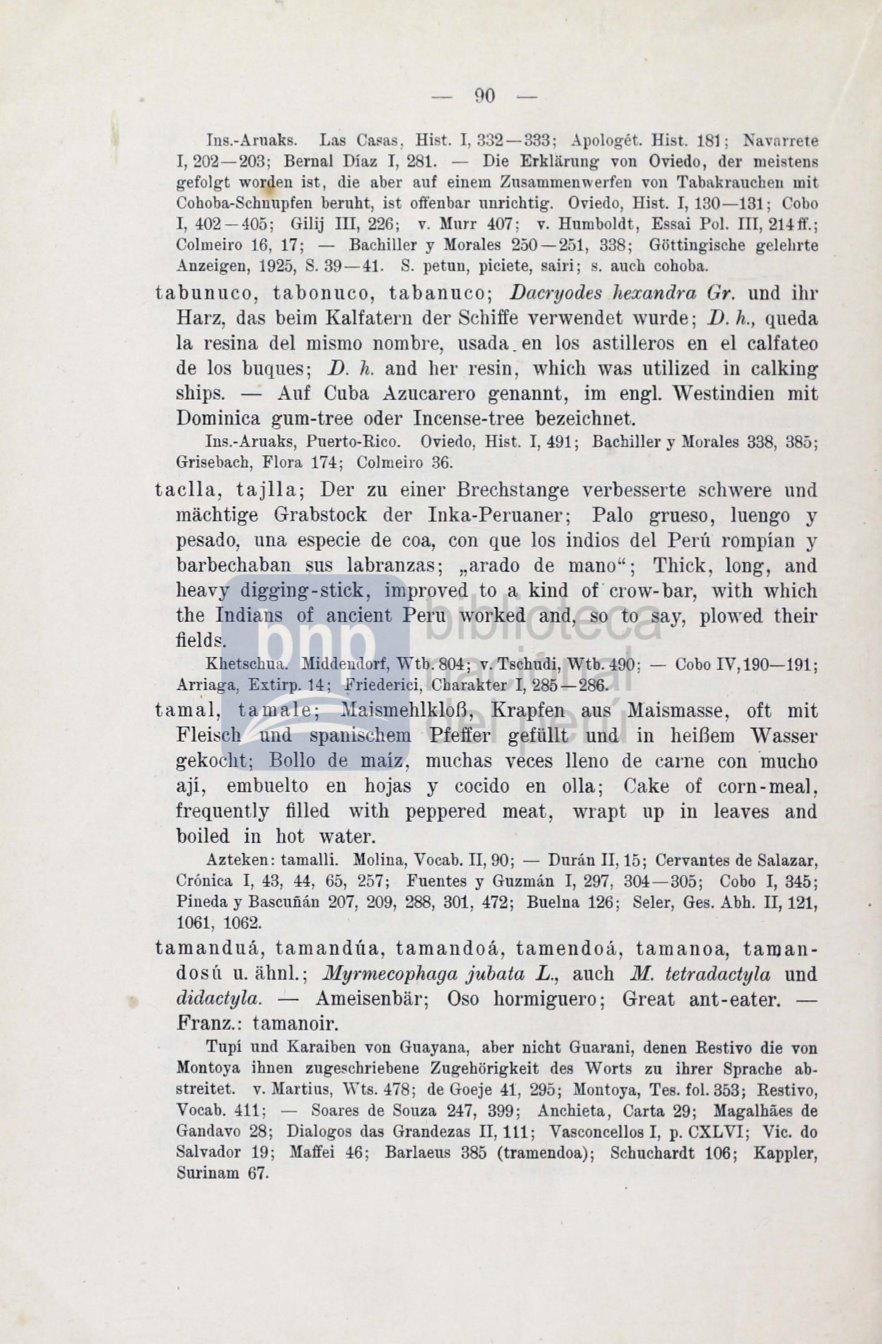

o
In .-A.rnak .
Ln.s
a.a ,
Hi
t.
I, 3 2-333 · A.pologét.
Hi
t.
1 1;
' aynrrete
I, 202-203 ; Berna! Díaz I , 281.
-
Die Erklarung von Oviedo, der mei ten
gefolgt worden ist , die aber auf einem Zn ammenwerfen von Tabakrauchen mit
Cohoba-Schnupfen beruht, i t offenbar unrichtig. Ovieclo, Hist. I, 130-131 ;
obo
I, 402 - 405; Gilij III, 226 ;
v. Murr 407 ; v. Humboldt , E sai Pol. III, 214-ff.;
Colmeiro 16, 17 ; -
Bachiller y Morales 250-251, 33 ; Gottingi che geleln-te
Anzeigen, 1925,
. 39 - 41. S. petun, piciete, sairi;
. auch cohoba.
tabun uco , tabonuco, ta ban u co;
Dacryodes hexandra Gr.
und ihr
Harz, das beim Kalfatern der chiffe verwendet wurde;
D. h.,
queda
la resina del mi mo nombre, usada . en los astillero
en el calfateo
de los buques;
D . h.
and her resin , wbich was utilized in calking
ships. -
Anf Cuba Azucarero genannt, im engl. Westindien mit
Dominica gum-tree oder Incense-tree bezeichnet.
Ins.-Aruaks, Puerto-Rico.
Oviedo, Hist. I, 491; Bachiller y Morales 338, 385;
Grisebach, Flora 174; Colmeiro 36.
taclla, tajlla; Der zu einer Brecbstange verbes erte
chwere und
macbtige Grab tock der Inka-Peruaner ; Palo grue o,
luengo y
pesado, una e pecie de coa, con que los indio del P erú rompían y
barbechaban sus labranzas;
,,arado de mano"; Thi ck , long, and
heavy digging-stick, improved to a kind of crow- bar, witb which
the
Indi~n
of ancient Peru MTorked
an~,
o to
ay, plowed their
:fields.
Khetschua. Mid endorf,
tb.804;
'V.Tsohud~,
Wtb. 490; -
Cobo IV,190-191;
A.rriaga, Extirp.
14_¡
.friederici, Cbarakter
I,
285- 2 6.
tamal, t male; Maj me lklofl, Krapfen au Maismasse , oft mit
Fleisch
11.ndspani e.hem Pfeffer gefüllt und in heiflem Wa ser
gekocht; Bollo de maíz , muchas veces lleno de carne con ·mucho
ají,
embuelto en hojas
y
cocido en olla; Cake of corn-meal,
frequently filled with peppered meat, wrapt up
in leaves and
boiled in bot water.
A.zteken: tamalli. Molina, Vocab. II, 90; -
Dnrán II, 15; Cervantes de Salazar,
Crónica I, 43, 44, 65, 257; Fuentes y Guzmán I, 297, 304 - 305; Cobo I, 345;
Pineda y Bascuñán 207, 209, 288, 301, 472; Buelna 126 ; Seler, Ges. Abh. II, 121,
1061, 1062.
tamanduá, tamandúa, tamandoá, tamendoá, tamanoa, taman–
dos
ú
u. ahnl.;
Myrmecophaga jubata L .,
auch
M. tetradactyla
und
didactyla.
-
Ameisenbar; Oso hormiguero; Great ant-eater. -
Franz.: tamanoir.
Tupí und Karaiben von Guayana, aber nicht Guaraní, denen Restivo die von
Montoya ihnen zugeschriebene Zugehürigkeit des Worts zu
ihrer Sprache ab–
streitet.
v. Martius, Wts. 478 ; de Goeje 41, 295; Montoya, Tes. fol. 353; Restivo,
Vocab. 411 ; -
Soares de Souza 247, 399 ; Anchieta, Carta 29; Magalbaes de
Gandavo 28; Dialogos das Grandezas II, 111; Vasconcellos I, p. CXLVI; Vic. do
Salvador 19 ; Maffei 46; Barlaeus 385 (tramendoa); Schuchardt 106; Kappler,
Surinam 67.
















